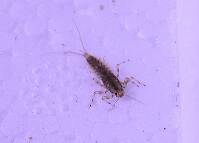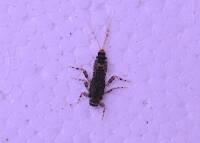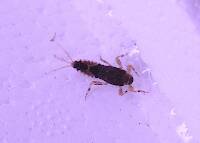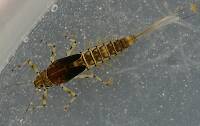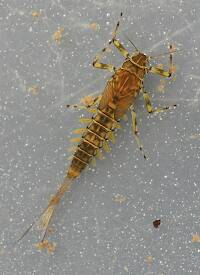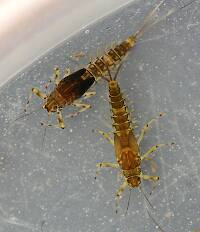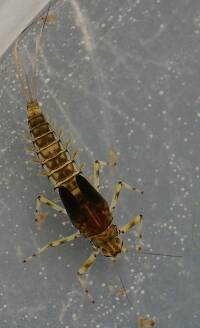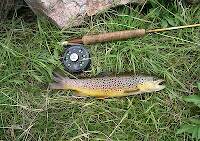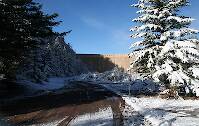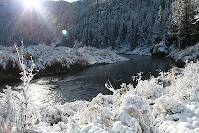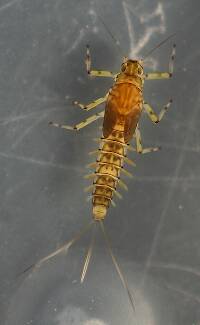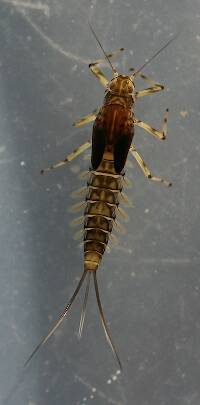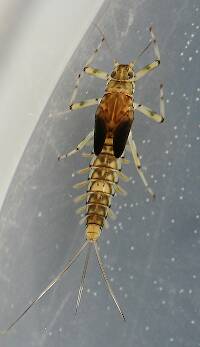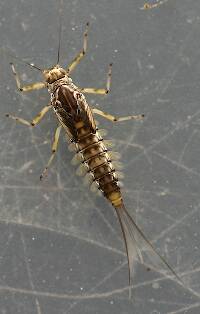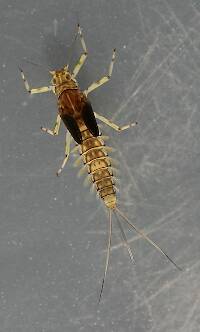
Hex Mayflies
Hexagenia limbata
The famous nocturnal Hex hatch of the Midwest (and a few other lucky locations) stirs to the surface mythically large brown trout that only touch streamers for the rest of the year.
Featured on the forum

Troutnut is a project started in 2003 by salmonid ecologist Jason "Troutnut" Neuswanger to help anglers and
fly tyers unabashedly embrace the entomological side of the sport. Learn more about Troutnut or
support the project for an enhanced experience here.
Scruffyfish has attached this picture to aid in identification. The message is below.
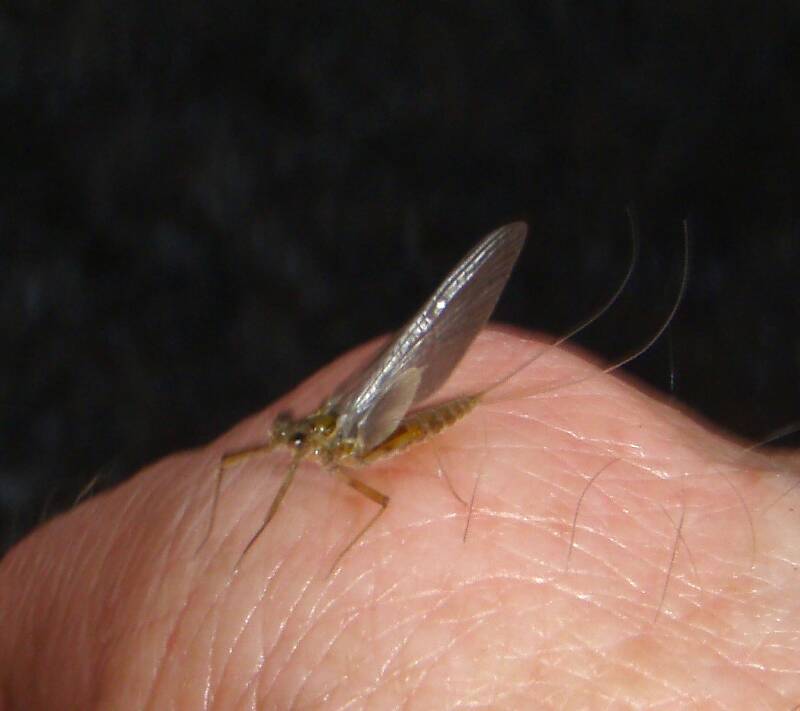
Scruffyfish
Posts: 6
Posts: 6
Scruffyfish on Apr 17, 2012April 17th, 2012, 4:33 am EDT
Hi all!
I fished a small wild trout stream yesterday in southern NH with several hatches coming off. This was the only photo I could get of one of the mayflies. I'm thinking Baetis?
I fished a small wild trout stream yesterday in southern NH with several hatches coming off. This was the only photo I could get of one of the mayflies. I'm thinking Baetis?
Crepuscular on Apr 17, 2012April 17th, 2012, 6:41 am EDT
What is the size? Hind wing doesn't look like Baetis to me. Heptageniidae, Epeorus
PaulRoberts on Apr 17, 2012April 17th, 2012, 7:48 am EDT
Yes, it's Epeorus. Heptageniidae -"clinger" type with a big wide head, wider flatter stance, and two tails. Baetis is usually smaller (at least this early as some summer Epeorus can be pretty small), more delicate, smaller head, shorter legged, also two-tailed. Which Epeorus? Dunno. Wait on the experts.
Here's a pic of a Baetis dun I took yesterday:

Here's a pic of a Baetis dun I took yesterday:

Entoman on Apr 17, 2012April 17th, 2012, 12:47 pm EDT
How big are the flies?
Paul - Yours looks like a female tricaudatus dun.
Scruffy - Notice how Paul's specimen has a really tiny hind hing held horizontally? Baetids either have wings like this or no hind wings at all.
The common species this time of year is Epeorus pleuralis (Quill Gordon), but it's a pretty good sized critter. It doesn't look to be, but if yours is over 9mm, that's probably your answer. If it isn't that big, there are a lot of heptageniid possibilites that can't be excluded from what's observable in your photo, though the pain wings and marked femurs are certainly suggestive of Epeorus.
Paul - Yours looks like a female tricaudatus dun.
Scruffy - Notice how Paul's specimen has a really tiny hind hing held horizontally? Baetids either have wings like this or no hind wings at all.
The common species this time of year is Epeorus pleuralis (Quill Gordon), but it's a pretty good sized critter. It doesn't look to be, but if yours is over 9mm, that's probably your answer. If it isn't that big, there are a lot of heptageniid possibilites that can't be excluded from what's observable in your photo, though the pain wings and marked femurs are certainly suggestive of Epeorus.
"It's not that I find fishing so important, it's just that I find all other endeavors of Man equally unimportant... And not nearly as much fun!" Robert Traver, Anatomy of a Fisherman
Scruffyfish
Posts: 6
Posts: 6
Scruffyfish on Apr 17, 2012April 17th, 2012, 2:01 pm EDT
Entoman,
As I recall it was about 9mm, and had a slightly oval body. I think you're all correct with Epeorus. The two tails and size made me think of Baetis. I had never fished this stream before and I was not familiar with it's hatches. There were several mayflies coming off, one with three very long tails, but I couldn't capture it to identify what it was. Any thoughts, Southern NH in mid April?
Hatching is mixed up this year, the Black Quill in my pond hatched today, about two to three weeks early. Crazy weather, no water from snow run off, to speak of and very, very dry.
BTW, the fishing was excellent for the native fish.
As I recall it was about 9mm, and had a slightly oval body. I think you're all correct with Epeorus. The two tails and size made me think of Baetis. I had never fished this stream before and I was not familiar with it's hatches. There were several mayflies coming off, one with three very long tails, but I couldn't capture it to identify what it was. Any thoughts, Southern NH in mid April?
Hatching is mixed up this year, the Black Quill in my pond hatched today, about two to three weeks early. Crazy weather, no water from snow run off, to speak of and very, very dry.
BTW, the fishing was excellent for the native fish.
Entoman on Apr 17, 2012April 17th, 2012, 3:17 pm EDT
Scruffy -
Yes, I understand the hatches are early back there. Out here, we had a warm winter drought, but are still experiencing a cold wet Spring. I think about the time our season opens (end of the month) the hatches will be timed about right with low water conditions, if it ever stops raining!
Paul -
Thanks for the enlargement! Wow, that's about as big a projection as I've ever seen on a baetid. The two longidudinal unforked veins (with what looks like a weakly developed third at the margin) and the lack of crossveins looks like examples I've seen in the rhodani group. I hope Luke sees the photo and weighs in. How big was the critter?
Yes, I understand the hatches are early back there. Out here, we had a warm winter drought, but are still experiencing a cold wet Spring. I think about the time our season opens (end of the month) the hatches will be timed about right with low water conditions, if it ever stops raining!
Paul -
Thanks for the enlargement! Wow, that's about as big a projection as I've ever seen on a baetid. The two longidudinal unforked veins (with what looks like a weakly developed third at the margin) and the lack of crossveins looks like examples I've seen in the rhodani group. I hope Luke sees the photo and weighs in. How big was the critter?
"It's not that I find fishing so important, it's just that I find all other endeavors of Man equally unimportant... And not nearly as much fun!" Robert Traver, Anatomy of a Fisherman
PaulRoberts on Apr 17, 2012April 17th, 2012, 3:52 pm EDT
About an 18.
Entoman on Apr 17, 2012April 17th, 2012, 3:55 pm EDT
Scruffy -
BTW - the basal costal crossveins (little cross veins on the lower leading edge of the big wing) are slanting up, which is a character associated with E. pleuralis. Perhaps this specimen represents a strain that's just a bit on the small (and distinctly olive) side.
BTW - the basal costal crossveins (little cross veins on the lower leading edge of the big wing) are slanting up, which is a character associated with E. pleuralis. Perhaps this specimen represents a strain that's just a bit on the small (and distinctly olive) side.
"It's not that I find fishing so important, it's just that I find all other endeavors of Man equally unimportant... And not nearly as much fun!" Robert Traver, Anatomy of a Fisherman
Entoman on Apr 17, 2012April 17th, 2012, 4:18 pm EDT
18? Well, based on that and those big projections, I'm going to switch gears and go with flavistriga.
"It's not that I find fishing so important, it's just that I find all other endeavors of Man equally unimportant... And not nearly as much fun!" Robert Traver, Anatomy of a Fisherman
Konchu on Apr 17, 2012April 17th, 2012, 5:14 pm EDT
i doubt the projection is as big as it seems on first glance. if i tilt my head just right, squint one eye, and focus with the other, i can tell that there's an optical illusion going on with the projection of the hindwing and a vein in the forewing.
PaulRoberts on Apr 17, 2012April 17th, 2012, 5:49 pm EDT
Entoman on Apr 18, 2012April 18th, 2012, 1:02 am EDT
Ah! Thanks for the clarifying photo, Paul. That's a weird artifact of the projection appearing on the forewing just above the actual one. It may be the projection from the other hind wing showing through somehow in an alignment that really threw me off in the other photo.
Luke, how'd you do that? That's why you're the man!:)
OK, I'm back with tricaudatus by the process of elimination. These are the baetid possibilities known for CO (there are many other species but they are more easily dismissed for a variety of reasons):
Baetis
fuscatus group
1. flavistriga - wrong hindwings
2. notos - wrong hindwings
rhodani group
3. bicaudatus - wrong hindwings (just barely)
4. magnus - too big
5. tricaudatus
Diphetor
6. hageni - really wrong hindwings
In my experience Paul, this early in the season is usually tricaudatus time and they are also usually 16's and even up to 14's in some locales. B. bicaudatus as well as smaller broods of tricaudatus do run in size 18 and sometimes even smaller, but they are usually much later and bicaudatus (as already mentioned) lacks the third weakly developed longitudinal vein running along the outer margin of the hind wing that your photo shows.
Luke, how'd you do that? That's why you're the man!:)
OK, I'm back with tricaudatus by the process of elimination. These are the baetid possibilities known for CO (there are many other species but they are more easily dismissed for a variety of reasons):
Baetis
fuscatus group
1. flavistriga - wrong hindwings
2. notos - wrong hindwings
rhodani group
3. bicaudatus - wrong hindwings (just barely)
4. magnus - too big
5. tricaudatus
Diphetor
6. hageni - really wrong hindwings
In my experience Paul, this early in the season is usually tricaudatus time and they are also usually 16's and even up to 14's in some locales. B. bicaudatus as well as smaller broods of tricaudatus do run in size 18 and sometimes even smaller, but they are usually much later and bicaudatus (as already mentioned) lacks the third weakly developed longitudinal vein running along the outer margin of the hind wing that your photo shows.
"It's not that I find fishing so important, it's just that I find all other endeavors of Man equally unimportant... And not nearly as much fun!" Robert Traver, Anatomy of a Fisherman
Creno on Apr 18, 2012April 18th, 2012, 4:19 pm EDT
"These are the baetid possibilities known for CO (there are many other species but they are more easily dismissed for a variety of reasons):"
I just have to bring it up one more time - placing names on critters based on reported distribution presumes no more new distribution records, or new species, will be found again. Clearly that is not the case - even for mayflies.
I just have to bring it up one more time - placing names on critters based on reported distribution presumes no more new distribution records, or new species, will be found again. Clearly that is not the case - even for mayflies.
Entoman on Apr 18, 2012April 18th, 2012, 5:46 pm EDT
Thanks, Dave. It's always good to remind readers of this from time to time. Though in this case (CO baetids), sorting out what's already been found is probably more problematic than the possibility of new distributions or undiscovered species.:)
"It's not that I find fishing so important, it's just that I find all other endeavors of Man equally unimportant... And not nearly as much fun!" Robert Traver, Anatomy of a Fisherman
Quick Reply
Related Discussions
Topic
Replies
Last Reply
3
Oct 4, 2006
by GONZO
by GONZO
1
Oct 28, 2008
by GONZO
by GONZO
6
Dec 19, 2006
by DeRidder
by DeRidder
0
Nov 6, 2020
by Troutnut
by Troutnut
4
Dec 22, 2009
by Oldredbarn
by Oldredbarn









